
The peony or paeony is a flowering plant in the genus Paeonia, the only genus in the family Paeoniaceae. Peonies are native to Asia, Europe, and Western North America. Scientists differ on the number of species that can be distinguished, ranging from 25 to 40, although the current consensus describes 33 known species. The relationships between the species need to be further clarified.

Paeonia brownii is a low to medium height, herbaceous perennial flowering plant in the family Paeoniaceae. It has compound, steely-gray, somewhat fleshy leaves and small drooping maroon flowers. Its vernacular name is Brown's peony, native peony or western peony. It is native to the western United States and usually grows at altitude, often as undergrowth in part-shade. The fleshy roots store food to carry the plant through the dry summers and produce new leaves and flowers the following spring.
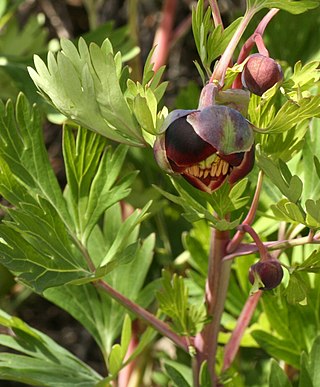
Paeonia californica is a perennial herbaceous plant of 35–70 cm high, that retreats underground in summer, and reoccurs with the arrival of the winter rains. It has lobed leaves, elliptic (cup-shaped) drooping flowers with dark maroon-colored petals, and many yellow anthers. It flowers mostly from January to March, and later develops two to five fruits per flower. Its common name is California peony and it is sometimes also referred to as wild peony. This peony is an endemic of southwestern California (USA), where it is not rare, and northernmost Baja California (Mexico). It grows on dry hillsides in the coastal sage scrub and chaparral communities of the coastal mountains of Southern and Central California, often as an understory plant.
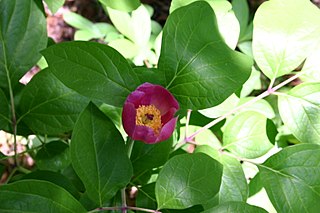
Paeonia obovata is a perennial herbaceous species of peony growing 30–70 cm high. It has white, pink or purple-red flowers and its lower leaves consist of no more than nine leaflets or segments. In English it is sometimes called woodland peony. It grows naturally in warm-temperate to cold China, including Manchuria, and in Korea, Japan, Far Eastern Russia and on Sakhalin.

Paeonia mascula is a species of peony. It is a herbaceous perennial 0.5–1.5 m (1.6–4.9 ft) tall, with leaves that are divided into three segments, and large red flowers in late spring and early summer. Native to Syria, Spain, France, Italy, Croatia, Bosnia and Herzegovina, Serbia, Cyprus, Montenegro, Bulgaria Greece, Turkey, Iraq, Lebanon and Israel, this wild peony has become naturalised on two small islands in the UK.
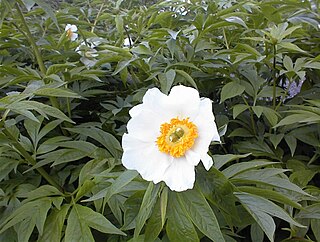
Paeonia emodi is a robust herbaceous perennial plant that winters with buds underground, has large white flowers and large deeply incised leaves, and belongs to the family Paeoniaceae. Its local vernacular names include mamekhor or mamekh (Punjabi), ood-e-saleeb (Urdu) meaning "with-a-cross", ood salap (Hindi), mid and 多花芍药 meaning "multi-flower peony". In English it is sometimes called Himalayan peony. It is among the tallest of the herbaceous peony species, and, while cold-hardy, it grows better in warm temperate climates. It is a parent of the popular hybrid 'White Innocence', which reaches 1½ m.

Paeonia officinalis, the common peony, or garden peony, is a species of flowering plant in the family Paeoniaceae, native to mainly mountainous areas of Southern Europe and introduced in Central and Western Europe and North America.
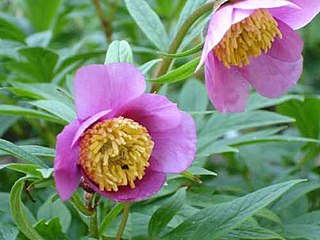
Paeonia veitchii is a species of herbaceous perennial peony. The vernacular name in China is 川赤芍. This species is ½-1 m high, has a thick irregular taproot and thin side roots, and deeply incised leaves, with leaflets themselves divided in fine segments. It has two to four fully developed flowers per stem, that may be pink to magenta-red or rarely almost white. It is known from central China.

Paeonia delavayi is a low woody shrub belonging to the peonies, that is endemic to China. The vernacular name in China is 滇牡丹. In English it is called Delavay's tree peony, Delavay peony, Dian peony, and dian mu dan. It mostly has red brown to yellow, nodding flowers from mid May to mid June. The light green, delicate looking deciduous leaves consist of many segments, and are alternately arranged on new growth.

Paeonia ludlowii, is a deciduous shrub of medium height, belonging to the tree peony section Moutan of the genus Paeonia, and endemic to southeast Tibet. In Tibet it is known as ≠'lumaidao' meaning "God's flower". The vernacular name in Chinese is 大花黄牡丹 meaning "big yellow-flowered peony". In English it is sometimes called Tibetan tree peony or Ludlow's tree peony. It has pure yellow, slightly nodding, bowl-shaped flowers, and large, twice compounded, light green leaves.
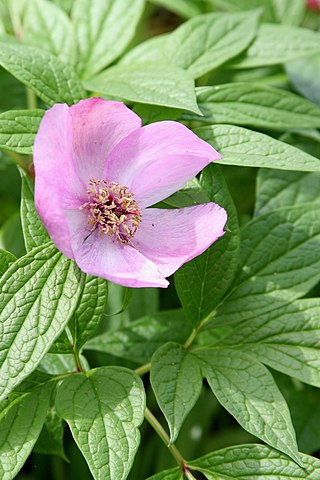
Paeonia mairei is a species of peony, that is endemic to the mountains of central China. Its vernacular name in China is 美丽芍药 meaning "beautiful peony". The plant may be between 45 and 100 cm high and has mostly rose-pink flowers of about 10 cm across, one on each stem. P. mairei blooms in early spring.
Paeonia sterniana is a perennial, herbaceous peony of approximately 45 cm high in cultivation, with white or sometimes pinkish flowers. It grows in the wild in southeastern Tibet. This peony is very rare in cultivation. It produces blue seeds in autumn. Its common name in Chinese is 白花芍药, which means "white peony".

Paeonia tenuifolia is a herbaceous species of peony that is called the steppe peony or the fern leaf peony. It is native to the Caucasus Mountains, with large fields found in Vashlivani National Park in Georgia and the Black Sea coast of Ukraine, spreading westward into Bulgaria, Romania and Serbia and eastward to northwestern Kazakhstan. It was described by Linnaeus in 1759. The leaves are finely divided into almost thread-like segments and grow close together on the stems. This peony can reach 30–60 cm (12–24 in) in height. The scented red flowers have numerous yellow stamens in the centre.

Paeonia clusii is a relatively low (25–50 cm) species of herbaceous peony with scented, white or pink flowers of up to 12 cm in diameter. In the wild, the species can only be found on the islands of Crete and Karpathos, and Rhodes. It has pinkish-purple stem up to 30 cm long and glaucous dissected leaves. P. clusii blooms in mid-spring.

Paeonia cambessedesii is a perennial herbaceous species of peony about 45 cm high. It has pink flowers. The stems, major veins and undersides of the leaves remain purple red, while the upper surface of the leaves turns into a metallic bluish green when fully grown and its lower leaves consist of no more than nine leaflets or segments. This endemic of the Balearic Islands is now limited to parts of northeastern and northwestern Majorca. In English it is sometimes called Balearic peony or Majorcan peony.

Paeonia anomala is a species of herbaceous perennial flowering plant in the family Paeoniaceae. This peony is ½-1 m high, with a thick irregular taproot and thin side roots. The deeply incised leaves have leaflets which are themselves divided in fine segments. It flowers in early summer, almost always with only one fully developed flower per stem, magenta-red or rarely pink or white. The species occurs in a zone between northern European Russia and northern Mongolia and south to the Tien Shan Mountains.

Paeonia daurica is a perennial herbaceous plant belonging to the peony family. It has slender carrot-shaped roots, leaves mostly consisting of nine leaflets, with one flower per stem. The flower is subtended by none to two leafy bracts, and has two or three sepals, five to eight petals, and many stamens. The subspecies vary in the colour of the petals, the size and shape of the leaflets, and the hairiness of the leaflets and the carpels. Paeonia daurica can be found from the Balkans to Iran, and the Crimea to Lebanon, with the centre of its distribution in the Caucasus. It is also cultivated as an ornamental.
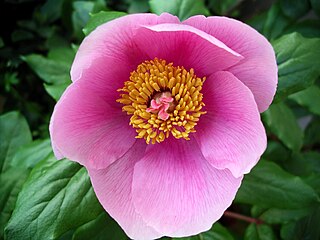
Paeonia corsica, also known as the Corsican peony, is a perennial herbaceous plant of 35–80 cm (14–31 in) high that belongs to the peonies. It naturally occurs on Corsica, Sardinia, on the Ionian islands and in western Greece. It has hairless green to purple stems, and the lower leaves consist mostly of nine leaflets with undersides which may carry felty hairs or are hairless. Its flowers have pink petals and purple filaments. Its vernacular name in Italian is peonia Corsa, and in French pivoine de Corse, both meaning "Corsican peony".
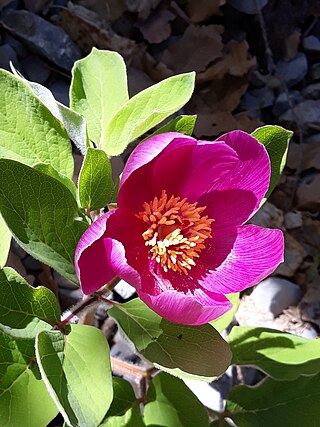
Paeonia algeriensis, also known as the Algerian peony, is a herbaceous species of peony that naturally occurs in the coastal mountain range of Algeria (Kabylie). It has solitary flowers with pink to magenta petals and one or two carpels per flower, that develop into follicles of about 5 cm long.
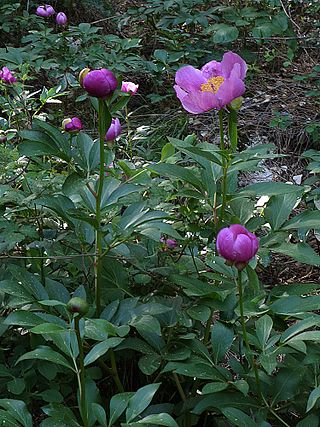
Paeonia coriacea, also known as the Andalusian peony, is a species of flowering plant within the family Paeoniaceae.




















